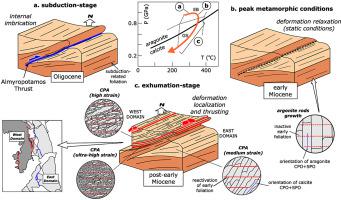Journal of Structural Geology ( IF 3.1 ) Pub Date : 2021-05-15 , DOI: 10.1016/j.jsg.2021.104373 Nikolaos Gerogiannis , Eirini Aravadinou , Vasileios Chatzaras , Paraskevas Xypolias

|
Calcite pseudomorphs after aragonite were recorded throughout the high-pressure marbles of the Basal Unit (Evia Island, Greece). The pseudomorphs form a columnar microstructure oriented normal to the foliation, which developed at peak metamorphic conditions within the stability field of aragonite. Modification of the columnar microstructure by bending of the long axis of the calcite pseudomorph and dynamic recrystallization, was mainly dependent on the intensity of subsequent, exhumation-related deformation. We used the degree of preservation or modification of the columnar microstructure observed in shear zones, to distinguish between the subduction- and exhumation-related nature of the studied shear zones. The degree of modification of the columnar microstructure was also used as a tool to investigate variations in strain intensity, recrystallization mechanism and kinematics during the exhumation of the high-pressure marbles. Combined field and microstructural data suggest that subduction-related ductile deformation preceded the growth of the columnar microstructure and was associated with internal imbrication by SE-directed thrusting. The ductile stage of the exhumation was characterized by strain localization at the middle and upper structural levels of the Basal Unit, and E-directed thrusting (i.e., northeast in pre-Neogene configuration). Final exhumation of the Basal Unit was achieved by top-to-the-E ductile to brittle thrusting, which was accompanied by syn-orogenic extension at the upper crustal levels.
中文翻译:

文石后的方解石假晶:解开高压大理石结构历史的工具(希腊埃维亚岛)
在整个基层单位(希腊埃维亚岛)的高压大理石中记录了文石后的方解石假晶。拟晶形形成垂直于叶面的柱状微结构,其在文石稳定场内的峰值变质条件下发展。通过方解石假晶长轴的弯曲和动态再结晶来改变柱状微观结构,主要取决于随后的与发掘相关的变形的强度。我们使用在剪切带中观察到的柱状微结构的保存或修饰程度,来区分研究剪切带的俯冲和发掘相关性质。柱状微结构的改性程度也用作研究应变强度变化的工具,高压大理石采掘过程中的再结晶机理和运动学。野外和微观结构数据的组合表明,俯冲相关的韧性变形先于柱状微观结构的生长,并与SE定向推挤引起的内部成岩作用有关。掘尸的延性阶段的特征是应变定位在基底单元的中上部结构水平,以及E向冲动(即在新近纪前构造的东北)。基底单元的最终发掘是通过从顶部到E的韧性到脆性推力实现的,同时伴随着上地壳水平的造山运动伸展。野外和微观结构数据的组合表明,俯冲相关的韧性变形先于柱状微观结构的生长,并与SE定向推挤引起的内部成岩作用有关。掘尸的延性阶段的特征是应变定位在基底单元的中上部结构水平,以及E向冲动(即在新近纪前构造的东北)。基底单元的最终发掘是通过从顶部到E的韧性到脆性推力实现的,同时伴随着上地壳水平的造山运动伸展。野外和微观结构数据的组合表明,俯冲相关的韧性变形先于柱状微观结构的生长,并与SE定向推挤引起的内部成岩作用有关。掘尸的延性阶段的特征是应变定位在基底单元的中上部结构水平,以及E向冲动(即在新近纪前构造的东北)。基底单元的最终发掘是通过从顶部到E的韧性到脆性推力实现的,同时伴随着上地壳水平的造山运动伸展。以及E导向推力(即新近纪前构造的东北方向)。基底单元的最终发掘是通过从顶部到E的韧性到脆性推力实现的,同时伴随着上地壳水平的造山运动伸展。以及E导向推力(即新近纪前构造的东北方向)。基底单元的最终发掘是通过从顶部到E的韧性到脆性推力实现的,同时伴随着上地壳水平的造山运动伸展。


























 京公网安备 11010802027423号
京公网安备 11010802027423号